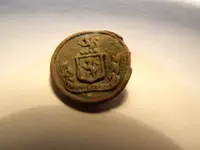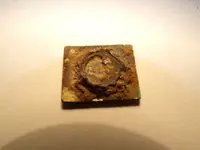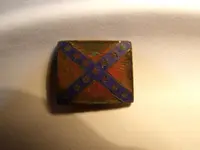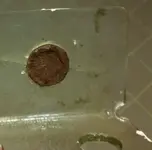"Soon after, John Wright of Birmingham, England discovered that potassium cyanide was a suitable electrolyte for gold and silver electroplating. Wright's associates, George Elkington and Henry Elkington were awarded the first patents for electroplating in 1840. These two then founded the electroplating industry in Birmingham from where it spread around the world."
Thanks for the link. This piece could have been electroplated on copper. This link explains that this was being done.
Another quote: By 1839, scientists in Britain and Russia had independently devised metal deposition processes similar to Brugnatelli's for the copper electroplating of printing press plates.
If you could electroplate copper on to metal, it seems that you could also do the reverse....or this was at least being worked with 15 years before the Civil war. 15 years is a long time to work with electroplating to get the kinks out of the process.
As far as enameling goes, enameling was started in Russia in 1760. The link to this history is here.
http://russian-crafts.com/crafts-history/enamel-history.html
This 1920's school that I mentioned was far smaller than it is today. The school has a new wing and the original building is a brick 2 story building. This find was on the very edge of the grounds. About three feet from where I dug this up, there is a boulder that is at least 4 tons in weight sitting on a spot. It is weathered and rounded. I will take a picture next time I go. The weather has been against us for about ten days now for making another trip.
Also, the three ringer bullets that we found were no more than 4 inches deep. (How an Etrac missed this is puzzling to me. The crew that hunted this before us used two Etracs and a Safari.) So, this ground was disturbed but not completely razzed by dozers used in 1920. There were mercury dimes found on this same plot also.
My point about the "Bloods Turf" was to emphasize that since about 1980, at least, this area of town is mostly made up of blacks buying up these older houses & populating the area. Block busting started here in the 60's. That is where one black family was assisted financially so that property values would decline and thus there was a quick sell off whites leaving and blacks coming in to homes that had been devalued. I know this sounds bad but this is what happened.
I don't think that from about 1970 onward, you would have anyone wearing a piece like this. So this makes the find at least 40+ years old.
The fact that this school was built in a posh area at the time of 1920, suggests that this find was 1920 or before the school was built since there have not been any other homes built near this school since that time.
So it is quite possible for this to be a period piece since the technology was in place. Like any new technology, it was popular as it caught on because it was new and made beautiful things.
I did post that one Civil War General wore an enameled piece during the Atlanta campaign. It was enameled on gold. So before the war, pieces like this were being made & this example says that at least on Civil War Soldier wore and enameled piece.
I too have learned a lot during this discourse. I want to thank everyone who posted. I too think that you have given up on life if you quit trying to learn new things. I have learned a lot here.











